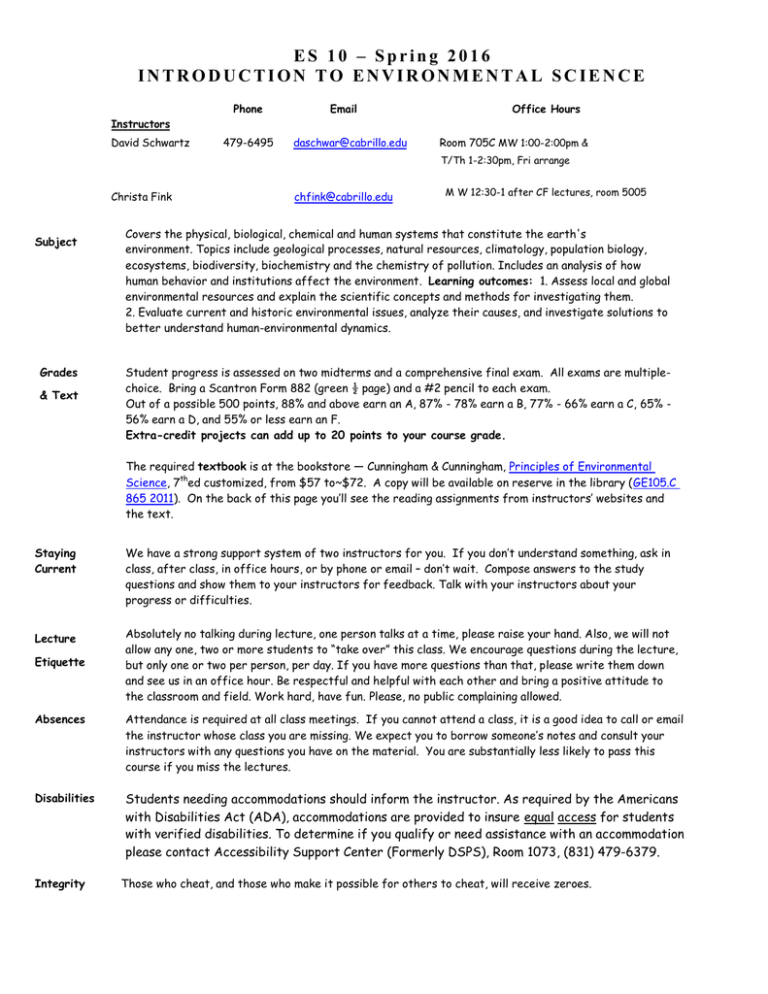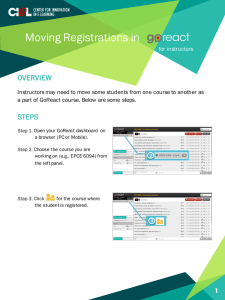E S 1 0 – ... I N T R O D U C T I...
advertisement

ES 10 – Spring 2016 INTRODUCTION TO ENVIRONMENTAL SCIENCE Phone Email Office Hours Instructors David Schwartz 479-6495 daschwar@cabrillo.edu Room 705C MW 1:00-2:00pm & T/Th 1-2:30pm, Fri arrange Christa Fink Subject Grades & Text chfink@cabrillo.edu M W 12:30-1 after CF lectures, room 5005 Covers the physical, biological, chemical and human systems that constitute the earth's environment. Topics include geological processes, natural resources, climatology, population biology, ecosystems, biodiversity, biochemistry and the chemistry of pollution. Includes an analysis of how human behavior and institutions affect the environment. Learning outcomes: 1. Assess local and global environmental resources and explain the scientific concepts and methods for investigating them. 2. Evaluate current and historic environmental issues, analyze their causes, and investigate solutions to better understand human-environmental dynamics. Student progress is assessed on two midterms and a comprehensive final exam. All exams are multiplechoice. Bring a Scantron Form 882 (green ½ page) and a #2 pencil to each exam. Out of a possible 500 points, 88% and above earn an A, 87% - 78% earn a B, 77% - 66% earn a C, 65% 56% earn a D, and 55% or less earn an F. Extra-credit projects can add up to 20 points to your course grade. The required textbook is at the bookstore — Cunningham & Cunningham, Principles of Environmental Science, 7thed customized, from $57 to~$72. A copy will be available on reserve in the library (GE105.C 865 2011). On the back of this page you’ll see the reading assignments from instructors’ websites and the text. Staying Current We have a strong support system of two instructors for you. If you don’t understand something, ask in class, after class, in office hours, or by phone or email – don’t wait. Compose answers to the study questions and show them to your instructors for feedback. Talk with your instructors about your progress or difficulties. Lecture Absolutely no talking during lecture, one person talks at a time, please raise your hand. Also, we will not allow any one, two or more students to “take over” this class. We encourage questions during the lecture, but only one or two per person, per day. If you have more questions than that, please write them down and see us in an office hour. Be respectful and helpful with each other and bring a positive attitude to the classroom and field. Work hard, have fun. Please, no public complaining allowed. Etiquette Absences Attendance is required at all class meetings. If you cannot attend a class, it is a good idea to call or email the instructor whose class you are missing. We expect you to borrow someone’s notes and consult your instructors with any questions you have on the material. You are substantially less likely to pass this course if you miss the lectures. Disabilities Students needing accommodations should inform the instructor. As required by the Americans with Disabilities Act (ADA), accommodations are provided to insure equal access for students with verified disabilities. To determine if you qualify or need assistance with an accommodation, please contact Accessibility Support Center (Formerly DSPS), Room 1073, (831) 479-6379. Integrity Those who cheat, and those who make it possible for others to cheat, will receive zeroes. Environmental Science 10 Schedule Spring 2016 In addition to the text, you are required to study the lecture slides, additional reading assignments, and study questions posted at instructors’ websites: www.cabrillo.edu/~dschwartz, www.cabrillo.edu/~cfink (You can use the Computer Technology Center or the Library for access to these website materials.) DATE 1/25 M 1/27 W 2/1 M 2/3 W 2/8 M 2/10 W 2/17 W Class # 1 2 3 4 5 6 7 2/22 M 8 2/24 W 2/29 M 3/2 W 3/7M 3/9 W 3/14 M 3/16 W TOPIC Intro / Environmental Problems The Science Process Introduction to Chemistry & Biology Air Pollution – Acid Rain, Smog, Ozone Geologic Processes & Hazards Geologic Processes & Hazards MIDTERM I (125 pts) Person CF CF CF DS DS Instructor Materials + Text DS website & CF website CF website CF website + 2.2-2.3 Ch. Environ Systems… CF website + Chap “Air Pollution” Chapter 12 DS website Chapter 12 DS website Otter Project JP* CF website 9 10 11 12 13 14 15 Rock Cycle, Minerals & Soil Biomes and Diversity Biological Communities & Interactions Climate Change / Global Warming Water Resources Water Resources Environmental Toxicology & Health DS CF CF CF DS DS MF* Chapter 12 DS website CF website + Chap “Biomes & Biodiversity” CF website + 2.5 + Ch “Evln, Sp Intrns...” CF website + Chap “Climate” Chapter 11 DS website Chapter 11 DS website 3/21 M 16 MIDTERM II (125 pts) 3/23 W 4/4 M 4/6 W 4/11 M 4/13 W 4/18 M 17 18 19 20 21 22 Water Resources and Pollution Nonrenewable Energy Resources I Nonrenewable Energy Resources II Nonrenewable Energy Resources III Ocean Champions COI Plastic pollution in the Ocean DS DS DS DS DW* JH* Chapter 11 DS website 4/20 W 23 MIDTERM III (125 pts) 4/25 M 4/27 W 5/2 M 5/4 W 5/9 M 5/11 W 24 25 26 27 28 29 Sea Level Change, then and now Exxon Valdez and BP Oil Spills GMO‘s Food and Agriculture Water Supply Issues Invasive Species 5/18 W 30 Comprehensive Final Exam (125 pts) Instructors: DS = David Schwartz & CF = Christa Fink *Guest Speakers: DK = Denny Kelso JP = Jeff Palsgaard DW = David Wilmot MF = Myra Finkelstein DS & CF CF website Chapter 12 DS website Chapter 12 DS website Chapter 12 DS website DS website DS website SCANTRON 882 pencil DS DK* CF CF SH* CF DS website CF website DS website DS website CF website 10am -12:50pm JH = Jim Holm and Cabrillo Students SH = Sue Holt EXTRA CREDIT OPTION; Community Activity + Short Report: 10 points each, students can do up to two projects, 20 point maximum. Anyone enrolled in ES 10 may choose to do the “Community Activity + Short Report” project. Upon successful completion of one project, 10 extra points will be added onto your final score. You will need to perform at least 3 to 4 hours per project doing some type of community activity to earn 10 points. This activity must be verified and followed up with at least a half-page summary explaining the experience and relating it to the class. The following are examples of projects and/or groups who you might work with: attending the Oceanography 10 Bi-Annual Coastal Cleanup, attending related seminars or going out to sea, working with Save Our Shores, Surfrider Foundation, The Coastal Watershed Council (CWC), Department of Fish and Game, Moss Landing Marine Labs, Long Marine Lab and CSUMB. We encourage other ideas but all endeavors need to be approved by the Instructors before the work begins. The 1/2-page summary report is due two weeks (or sooner) after completion of the project. All Community Activity reports must be “Typed” (not hand written).
